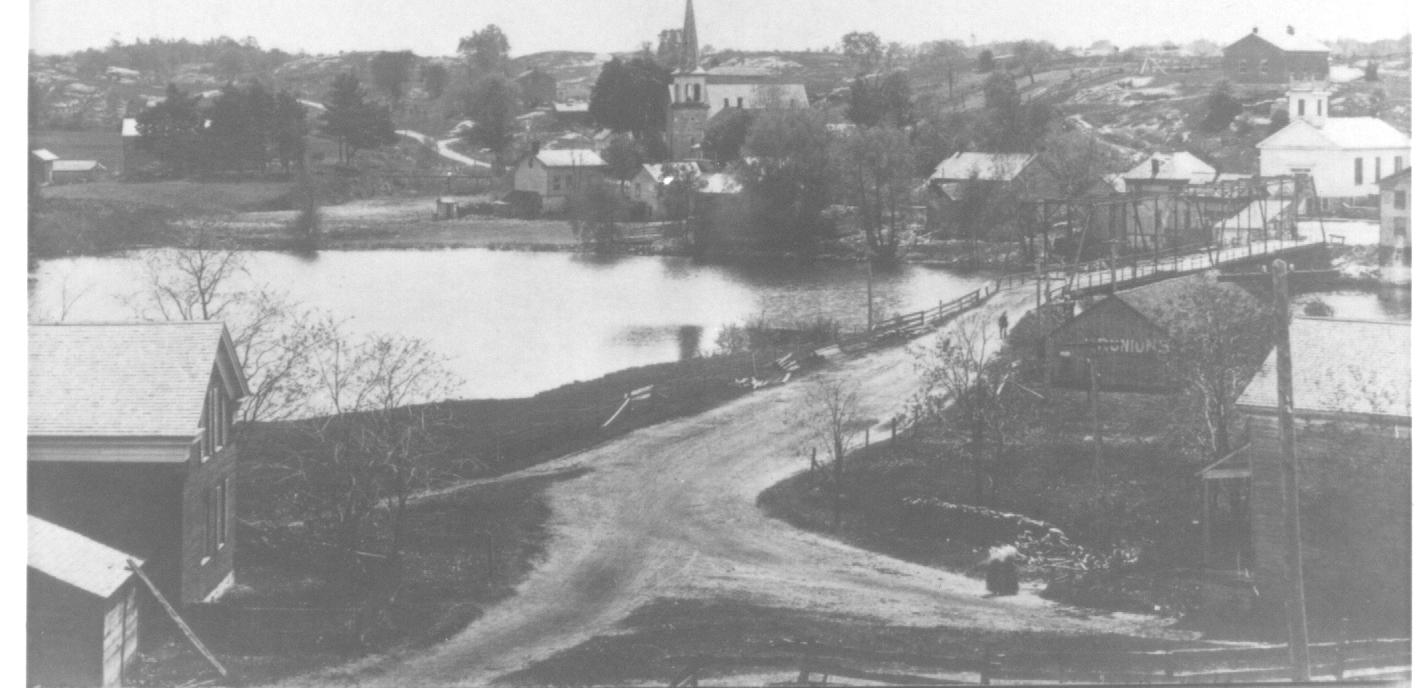
|

|

Near by is the site of the first iron blast furace in the northern new york. It was built in 1813 to smelt the ore from Caledonia iron mine at Spragueville. For many years all of this ore was hauled to Rossie, usually by Mr Parish's tenants. It was drawn up the hill & dumped into the top of the furnace.
In 1817 James Monroe, who was on a tour of northern New York, stopped at Rossie to inspect the furnace & the iron mine as a guess of David Parish. His vist was a great event in the lives of the early inhabitants, all of whom turned out to get a look at the president.
Near the blast furnace is located also the foundry which was built in 1848-49. It was the pioneer of the northland. Probably the first business was the making of potash & cauldron kettles. Then came the making of box stoves, mill machinery,plows,& waterweels. The first casting for the northern railroad were also made here.
Very little is now left of the machine shop which stood on the bank of the river next to the foundry. Across the river is a grist mill which was built in 1850, & at the right of the grist mill stood a large sawmill where the last of the lake boats, the "Oswegatchie" was built in 1904 by Arthur Storie.
Situated near the foundry is the former Parish land office, which had a special window for the easy dispensing of money & a brick vault in the basement. Across the bridge & outside the village toward Oxbow was the former David Parish farm.
The brick house was built in 1812. The barn, which housed many many valuable race horses, was built in 1815. The Rossie Hotel, a large rambling red bick building, was built by David Parish in 1811. In 1813 Rossie village was captured by the British, who stayed at the hotel over night. A gang of horse thieves, deserters from both sides of the St. Lawrence made there headquarters at Rossie, making raids in varous directions but chiefly into canada. They stole horses & hid them in the rocky ravines of Rossie area until they could sell them. There raids became so frequent to put a stop to them. With that in mind Colonel Frazier & a company of british regulars came over by way of Morristown. The "invading army" surrounded Rossie village & captured it, but because no horses could be found, the solders marched back the next day.
In 1868 a circus troupe stayed at the Rossie Hotel. The agreement provided for 75 people to sleep two to a bed at 50 cents each, cover for 160 horses with 3 pecks of oats for each horse, 400 pounds of hay for the elephants at 75 cents per hundredweight & 100 pounds of fresh beef at 4 cents a pound.
On the hill is the Parish cottage behind which was a large coach house. Here George Parish stayed over night & changed horses on his way from Ogdensburg to antwerp. Madame Vespucci was often his guest at the cottage. There love affair has been told by Walter Guest Kellogg in his novel "parish's Fancy."
A short distance toward hammond is the Laidlaw House, built in the early 1870's & the lscene of the famous Burns Festivas which were originated by the scotch settlers of Rossie. The festivals were held each year on jan. 25 in the honor of the scotch poet,Robert Burns. Among the names on the registers of the Laidlaw House were President Grover Cleveland,General Newton Martin Curtis, Famous hero of ft.Fisher,& Jay Gould of New York City.
About a mile from Rossie toward oxbow stands the Victoria Lead Mine Chimney, where lead was discovered by the nine-year old Eliza Jepson in 1830. She received a calico dress for her rich discovery & her father, Joel Jepson, was given 40 acres Of land, A team of oxen, & a barrel of salt pork. There were other lead mines, & the hills throughout the region today are honeycombed with shafts & prospect holes.
Because of the lead mining & the ofter industries there came to Rossie a wave of building which created much work & brought in many skilled labors. Rossie was the center of many activties & the village grew with the certainly of becoming a city. In the Rossie of that period there were select schools, milliners, doctors, dentists, coopers, blacksmiths, casket makers, slaughter houses, bowling alleys,& a chair factory. But in 1865 the connection of the Parish family with the North Country ended, & with the closing of the mines, which had been thought to be inexhaustible, ran out. The little village of Rossie had had its days of glory.

